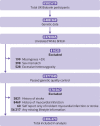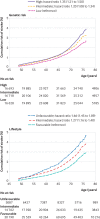Genetic risk, incident stroke, and the benefits of adhering to a healthy lifestyle: cohort study of 306 473 UK Biobank participants
- PMID: 30355576
- PMCID: PMC6199557
- DOI: 10.1136/bmj.k4168
Genetic risk, incident stroke, and the benefits of adhering to a healthy lifestyle: cohort study of 306 473 UK Biobank participants
Abstract
Objective: To evaluate the associations of a polygenic risk score and healthy lifestyle with incident stroke.
Design: Prospective population based cohort study.
Setting: UK Biobank Study, UK.
Participants: 306 473 men and women, aged 40-73 years, recruited between 2006 and 2010.
Main outcome measure: Hazard ratios for a first stroke, estimated using Cox regression. A polygenic risk score of 90 single nucleotide polymorphisms previously associated with stroke was constructed at P<1×10-5 to test for an association with incident stroke. Adherence to a healthy lifestyle was determined on the basis of four factors: non-smoker, healthy diet, body mass index <30 kg/m2, and regular physical exercise.
Results: During a median follow-up of 7.1 years (2 138 443 person years), 2077 incident strokes (1541 ischaemic stroke, 287 intracerebral haemorrhage, and 249 subarachnoid haemorrhage) were ascertained. The risk of incident stroke was 35% higher among those at high genetic risk (top third of polygenic score) compared with those at low genetic risk (bottom third): hazard ratio 1.35 (95% confidence interval 1.21 to 1.50), P=3.9×10-8. Unfavourable lifestyle (0 or 1 healthy lifestyle factors) was associated with a 66% increased risk of stroke compared with a favourable lifestyle (3 or 4 healthy lifestyle factors): 1.66 (1.45 to 1.89), P=1.19×10-13. The association with lifestyle was independent of genetic risk stratums.
Conclusion: In this cohort study, genetic and lifestyle factors were independently associated with incident stroke. These results emphasise the benefit of entire populations adhering to a healthy lifestyle, independent of genetic risk.
Published by the BMJ Publishing Group Limited. For permission to use (where not already granted under a licence) please go to http://group.bmj.com/group/rights-licensing/permissions.
Conflict of interest statement
Competing interests: All authors have completed the ICMJE uniform disclosure form at www.icmje.org/coi_disclosure.pdf and declare: no support from any organisation for the submitted work; HSM has been paid for delivering educational presentations for AstraZeneca; no other financial relationships with any organisations that might have an interest in the submitted work in the previous three years; no other relationships or activities that could appear to have influenced the submitted work.
Figures


References
-
- GBD 2013 Mortality and Causes of Death Collaborators Global, regional, and national age-sex specific all-cause and cause-specific mortality for 240 causes of death, 1990-2013: a systematic analysis for the Global Burden of Disease Study 2013. Lancet 2015;385:117-71. 10.1016/S0140-6736(14)61682-2 - DOI - PMC - PubMed
-
- Malik R, Chauhan G, Traylor M, et al. AFGen Consortium. Cohorts for Heart and Aging Research in Genomic Epidemiology (CHARGE) Consortium. International Genomics of Blood Pressure (iGEN-BP) Consortium. INVENT Consortium. STARNET. BioBank Japan Cooperative Hospital Group. COMPASS Consortium. EPIC-CVD Consortium. EPIC-InterAct Consortium. International Stroke Genetics Consortium (ISGC) METASTROKE Consortium. Neurology Working Group of the CHARGE Consortium. NINDS Stroke Genetics Network (SiGN) UK Young Lacunar DNA Study. MEGASTROKE Consortium. MEGASTROKE Consortium Multiancestry genome-wide association study of 520,000 subjects identifies 32 loci associated with stroke and stroke subtypes. Nat Genet 2018;50:524-37. 10.1038/s41588-018-0058-3 - DOI - PMC - PubMed
MeSH terms
Grants and funding
LinkOut - more resources
Full Text Sources
Medical
